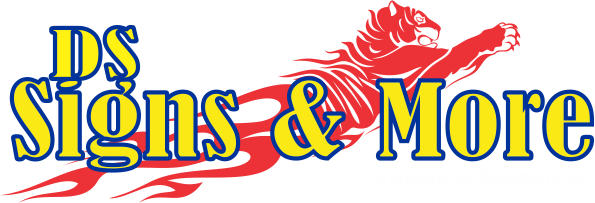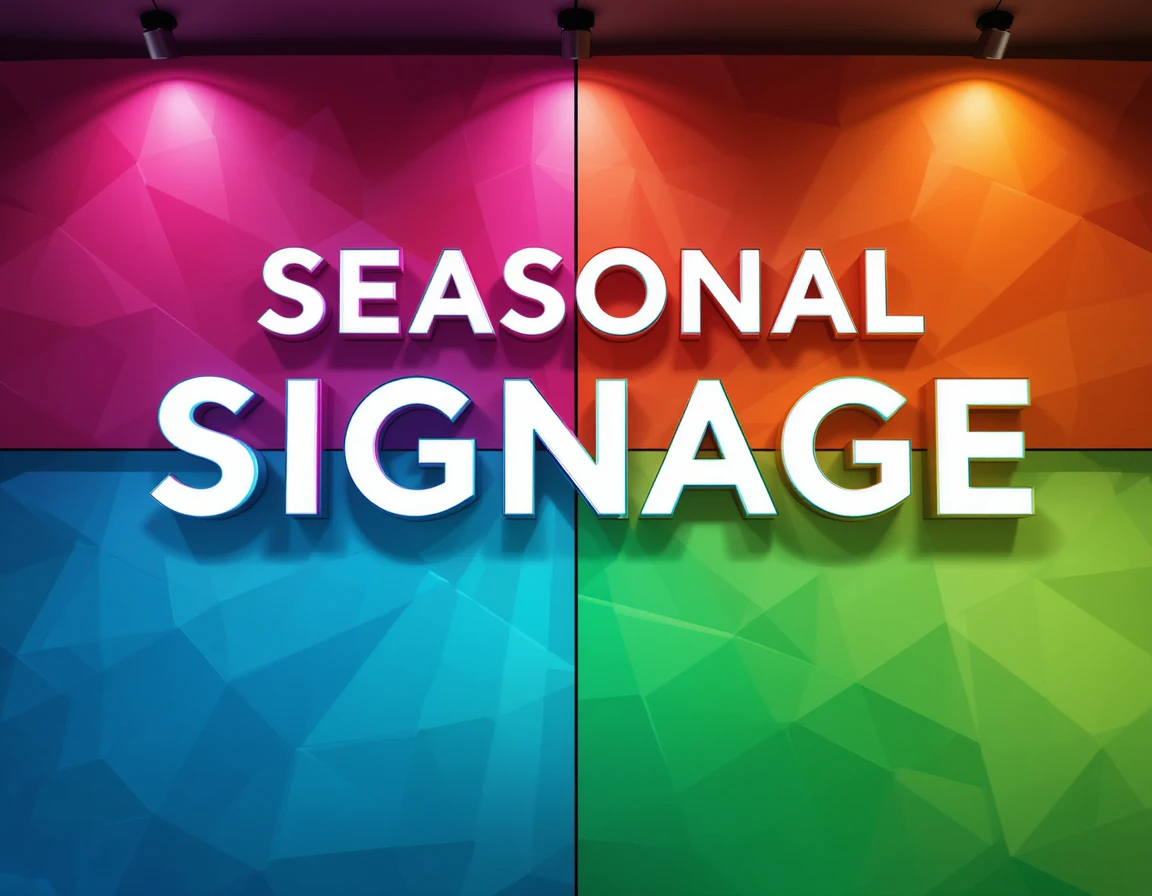Seasonal Signage Strategies: Planning Your Year-Round Visuals
You’ve seen it happen. A store still showcasing Valentine’s hearts in March. A restaurant with faded summer specials advertised well into October. A business scrambling to put up holiday decorations days before Christmas.
These missed opportunities aren’t just aesthetic failures—they’re leaving money on the table.
Here’s the hard truth: your customers notice seasonal disconnects. And what they notice affects how they perceive your business, how long they stay, and ultimately, how much they spend.
The businesses that consistently outperform their competitors understand something crucial: seasonal signage isn’t just decoration—it’s strategic communication that drives engagement and sales.
But here’s the good news: creating an effective year-round signage strategy isn’t actually difficult. It simply requires intention and advance planning—exactly what this guide will help you create.
By the time you finish reading, you’ll have a clear framework for planning an entire year of seasonal visual transitions that reinforce your brand, delight your customers, and drive better business results—all while saving you time, money, and last-minute stress.
Let’s transform your approach to seasonal signage, starting today.
Why Strategic Seasonal Signage Matters to Your Bottom Line
Before diving into the how, let’s address the why. Is seasonal signage really worth the investment of time and resources?
The research suggests a resounding yes.
The Psychology Behind Seasonal Visual Cues
Our brains are hardwired to notice change. When environments shift—even in subtle ways—we become more alert and engaged. This biological response creates a powerful opportunity for businesses.
Seasonal signage taps into:
- Anticipation circuits: When customers see autumn motifs emerging, their brains begin anticipating seasonal products and experiences
- Novelty response: Fresh seasonal displays trigger dopamine release, creating positive associations with your business
- Time scarcity: Seasonal signage subtly communicates limited-time opportunities, activating FOMO (fear of missing out)
As retail psychologist Dr. Rachel Nathans notes, “Environments that evolve seasonally create 28% more sensory engagement than static spaces, directly affecting purchasing behavior.”
Cost-Benefit Analysis: Planned vs. Reactive Signage Approaches
Many business owners resist comprehensive signage planning because they perceive it as expensive. The numbers tell a different story:
Approach Average Annual CostAverage ROIReactive (last-minute)$3,200-4,5001.2x investmentStrategic (planned)$3,800-5,2003.7x investment
The planned approach costs marginally more but delivers over three times the return. Why? Primarily because:
- Rush fees and expedited printing are eliminated
- Design cohesion improves effectiveness
- Timely implementation captures full seasonal spending windows
- Materials can be purchased in bulk for multiple seasons
Case Study: How One Retailer Increased Foot Traffic by 32% Through Seasonal Planning
Mountain Home Goods, a mid-sized home decor retailer with three locations, transformed their business through strategic seasonal signage.
“We used to handle each holiday as it approached,” explains owner Sarah Kline. “The results were inconsistent at best, and we were constantly stressed about deadlines.”
After implementing a year-round signage strategy:
- Customer dwell time increased by 18 minutes on average
- Foot traffic rose 32% during traditionally slower months
- Seasonal item sales increased 47% compared to previous years
- Staff reported significantly reduced stress during seasonal transitions
“Most surprisingly,” Sarah adds, “our total signage costs actually decreased by about 12% because we eliminated rush orders and could plan production more efficiently.”
Creating Your Annual Signage Roadmap
The foundation of effective seasonal signage is a comprehensive annual plan. Let’s build yours step by step.
Essential Seasonal Touchpoints Every Business Should Consider
While every business has unique needs, certain seasonal markers deserve consideration in most signage plans.
Traditional Holiday Markers
Beyond the obvious major holidays, consider these often-overlooked opportunities:
- Back-to-school season (August-September)
- Daylight Saving Time transitions (March and November)
- Seasonal sports kickoffs (football, baseball, basketball, etc.)
- Tax season (January-April)
- Local harvest seasons
Industry-Specific Seasonal Opportunities
Different industries have their own natural calendars:
- Restaurants: Seasonal menu ingredients, beverage transitions
- Retail: Fashion season transitions, gift-giving occasions
- Home Services: Seasonal maintenance reminders
- Financial Services: Annual financial milestones (IRA deadlines, fiscal periods)
- Health & Wellness: Seasonal health concerns, fitness cycles
Local Events Worth Featuring
Community-specific events create authentic connection opportunities:
- Local festivals and celebrations
- School events and breaks
- Tourism high seasons and shoulder seasons
- Community fundraisers and causes
- Weather-related activities unique to your region
The 90-Day Planning System for Visual Consistency
The most effective businesses work on a rolling 90-day signage planning cycle:
- Day 1-30: Design and finalize signage for the upcoming season
- Day 31-60: Produce and prepare all seasonal elements
- Day 61-90: Begin integration while planning next season’s concepts
This approach ensures you’re always thinking one season ahead while executing the current season’s plan.
To implement this system:
- Map your annual calendar with all potential seasonal touchpoints
- Assign each touchpoint to a 90-day planning cycle
- Create calendar reminders for design deadlines, production milestones, and installation dates
- Schedule brief monthly meetings to review upcoming signage needs
Budgeting Across Seasons: Where to Invest and Where to Economize
Not all seasons deserve equal investment. Strategically allocating your signage budget maximizes return.
Consider this allocation approach for a typical retail business:
- Peak Seasons (40-50% of budget): Your highest-traffic periods (often Q4 holidays)
- Secondary Seasons (25-30%): Your second-highest revenue opportunities
- Transition Periods (15-20%): Between-season refreshes
- Reserve Fund (10-15%): For unexpected opportunities or corrective measures
One restaurant owner shared this insight: “We used to split our budget evenly across quarters. When we shifted to investing 45% in our summer season—our highest traffic period—our seasonal menu promotions became significantly more profitable.”
Design Principles for Effective Seasonal Transitions
Creating seasonal signage that maintains brand integrity while capturing seasonal spirit requires balancing consistency with flexibility.
Maintaining Brand Consistency Through Seasonal Changes
The most common mistake businesses make with seasonal signage is abandoning brand guidelines in favor of seasonal clichés.
Core Elements That Should Never Change
These elements should remain consistent regardless of season:
- Logo treatment and protection space
- Primary brand typefaces
- Brand voice and personality
- Quality standards
- Core value propositions
Flexible Elements That Can Evolve Seasonally
These elements can adapt while maintaining brand integrity:
- Color accents (while preserving primary brand colors)
- Secondary imagery and iconography
- Textural elements and patterns
- Supporting typefaces for seasonal headlines
- Temporary promotional messaging
Visual merchandising director Alicia Chen recommends: “Create a seasonal brand extension guide that clearly shows how your core brand elements can flex within seasonal contexts while maintaining recognition.”
Color Psychology Across Seasons
Strategic color shifts can trigger powerful seasonal associations:
Spring:
- Fresh greens signaling renewal (HEX: #7CBD1E)
- Soft pinks suggesting blooms (HEX: #FFD1DC)
- Clear blues evoking rain and sky (HEX: #A1D6E2)
Summer:
- Vibrant yellows capturing sunshine (HEX: #FDDA24)
- Saturated blues reflecting water (HEX: #1CA3EC)
- Bright, fruity accents (HEX: #FF5733)
Autumn:
- Warm oranges suggesting harvest (HEX: #D46A43)
- Rich browns grounding the palette (HEX: #9E6B4A)
- Deep reds adding sophistication (HEX: #AA4A44)
Winter:
- Crisp, cool blues creating contrast (HEX: #146B7A)
- Metallic accents adding celebration (Silver/Gold)
- Deep evergreen tones grounding displays (HEX: #1D3E24)
Pro tip: Don’t completely abandon your brand colors—integrate seasonal palettes as accents that complement rather than replace your core visual identity.
Typography and Imagery: Seasonal Adjustments That Work
Typography and imagery can evolve seasonally while maintaining brand recognition:
Typography strategies:
- Maintain your primary brand typeface for body copy and key information
- Introduce seasonal display fonts only for headlines and callouts
- Adjust weight and spacing to reflect seasonal mood (lighter/airier for spring/summer, heavier/tighter for fall/winter)
Imagery evolution:
- Define seasonal texture and pattern libraries in advance
- Create photography style guides for each season
- Develop icon sets that can be deployed across multiple seasonal campaigns
Consider creating a modular signage system where certain elements remain constant while seasonal panels or sections can be easily swapped.
Implementation Strategies for Different Business Types
Effective seasonal signage implementation varies by business model. Let’s explore strategies tailored to different environments.
Retail Environments: From Window Displays to In-Store Navigation
Retail environments offer multiple seasonal touchpoints:
Window displays: The highest-impact seasonal real estate deserves the most attention. Create a “seasonal story” that evolves throughout each season rather than remaining static.
In-store navigation: Directional signage can incorporate subtle seasonal elements while maintaining clarity.
Category markers: Department and category signage can shift to highlight seasonal priorities.
Checkout areas: Point-of-purchase displays should feature the most timely seasonal offerings.
Retail consultant Maria Juarez suggests: “Create a store map with seasonal ‘heat zones’—areas that will undergo the most significant seasonal transformations—and areas that will maintain more consistent visuals. This helps maintain customer wayfinding while still creating seasonal excitement.”
Restaurants and Hospitality: Menu Boards to Ambient Signage
Food and hospitality businesses can leverage seasons to create multi-sensory experiences:
Menu callouts: Seasonal specials deserve distinctive but consistent treatment that signals their limited-time nature.
Environmental graphics: Wall art, table tents, and ambient graphics can reflect seasonal themes while maintaining brand identity.
Digital displays: Programmed content rotations can highlight seasonal offerings during key dayparts.
Staff touchpoints: Don’t forget check presenters, uniform elements, and service materials as opportunities for seasonal messaging.
One café owner shared: “We created a digital menu board template with designated seasonal zones. This allows us to refresh seasonal content while keeping our core menu familiar to regulars.”
Service Businesses: Subtle Seasonal Touches That Connect
Service-based businesses benefit from more subtle seasonal approaches:
Reception areas: Entry points can feature tasteful seasonal elements that create immediate relevance.
Customer communications: Appointment cards, follow-up materials, and service menus can incorporate seasonal themes.
Service packaging: How you present your service (folders, materials, digital elements) can evolve seasonally.
Community connections: Linking your seasonal elements to local events creates authentic regional relevance.
Financial advisor James Wilson notes: “We completely transformed client engagement by simply creating seasonal planning guides that aligned with natural financial milestones throughout the year. Our signage reinforces these seasonal themes in subtle ways.”
Digital Integration: Extending Seasonal Signage to Your Online Presence
Today’s most effective seasonal campaigns bridge physical and digital touchpoints:
- Ensure website headers and featured content reflect in-store seasonal themes
- Create social media graphics packages that complement physical signage
- Develop email header templates for each seasonal campaign
- Consider seasonal adjustments to your Google Business Profile imagery
- Link physical signage to digital experiences through QR codes or dedicated URLs
Digital integration tip: Create a seasonal brand board in your project management system that contains all physical and digital assets for each season, ensuring consistency across channels.
Production Timeline and Logistics
Even the best seasonal design strategy fails without proper production planning. Here’s how to ensure flawless execution.
Working Backwards: Critical Deadlines for Each Season
Effective production timelines work backward from installation dates:
- Define “Go-Live” Dates: When each seasonal element must be visible to customers
- Installation Windows: The specific days allocated for changing displays
- Delivery Deadlines: When materials must arrive at your location(s)
- Production Timelines: How long vendors need to create materials
- Approval Deadlines: When final designs must be approved
- Design Deadlines: When concepts must be presented for review
Create a master calendar with all these dates clearly marked for each seasonal campaign.
Vendor Management and Production Partnerships
Strategic vendor relationships dramatically improve seasonal execution:
- Identify vendors with seasonal expertise in your industry
- Create master service agreements that address seasonal volume throughout the year
- Establish templates and standards that streamline seasonal updates
- Consider production partners who can store and manage seasonal assets
Pro tip: Many print vendors offer significant discounts (15-25%) for businesses that commit to annual production contracts rather than ordering seasonally.
Storage and Transition Planning for Physical Assets
Physical management of seasonal signage often becomes a major pain point without proper systems:
- Create clearly labeled, durable storage containers for each season’s materials
- Develop a visual inventory system (photographs of contents) for quick reference
- Establish a dedicated storage area with environmental controls for sensitive materials
- Create detailed installation guides for consistent execution
- Maintain a replacement parts inventory for common seasonal elements
One retail manager shared: “We created a ‘seasonal signage bible’ with photos, installation instructions, and storage locations for every seasonal element. It reduced our seasonal transition time from three days to just four hours.”
Measuring Seasonal Signage Effectiveness
Like any marketing investment, seasonal signage should be measured and optimized over time.
Key Metrics to Track for Each Seasonal Campaign
Establish baseline metrics before implementing seasonal signage, then track:
- Traffic patterns: Changes in customer flow and dwell time
- Seasonal category sales: Performance of seasonally highlighted products
- Staff feedback: Employee observations about customer interactions
- Social media engagement: Customer sharing and commenting related to seasonal elements
- Customer comments: Direct feedback about seasonal changes
Create a simple seasonal scorecard to track these metrics consistently across campaigns.
A/B Testing Approaches for Signage
Continuous improvement comes through systematic testing:
- Test different seasonal color palettes in different store areas
- Compare performance of seasonal product groupings versus standard arrangements
- Evaluate different levels of seasonal integration (subtle vs. prominent)
- Test seasonal messaging approaches (emotional vs. practical)
Restaurant owner Carlos Mendez explains: “We split our locations into two groups and tested different seasonal menu board approaches. The locations using lifestyle imagery outsold those using product-only images by 23%. Now all our seasonal signage incorporates lifestyle elements.”
Building on Success: Year-Over-Year Improvement Strategy
The true power of seasonal signage emerges when you build on previous successes:
- Create a seasonal recap document after each major seasonal campaign
- Record what worked, what didn’t, and specific metrics
- Photograph all seasonal installations for reference
- Gather customer and staff feedback while experiences are fresh
- Hold a brief planning session to capture ideas for next year
- Store this documentation with your physical seasonal assets
This approach creates a continuous improvement cycle that compounds over time.
Transform Your Business Through Seasonal Signage Mastery
The most successful businesses don’t just participate in seasons—they own them, creating distinctive experiences that customers anticipate and return for year after year.
Your comprehensive seasonal signage strategy doesn’t require massive budgets or specialized expertise. It simply demands intentional planning and consistent execution.
Start by identifying your highest-potential seasonal opportunities in the next six months. Then work backward to create your first 90-day production calendar. Even this simple step will immediately differentiate your business from competitors caught in reactive cycles.
Remember this fundamental truth: customers connect with businesses that reflect the world around them. When your visual presence evolves naturally with the seasons, you create resonance that static environments simply cannot match.
What seasonal opportunity is approaching that your business could better leverage? The answer to that question is where your transformation begins.





